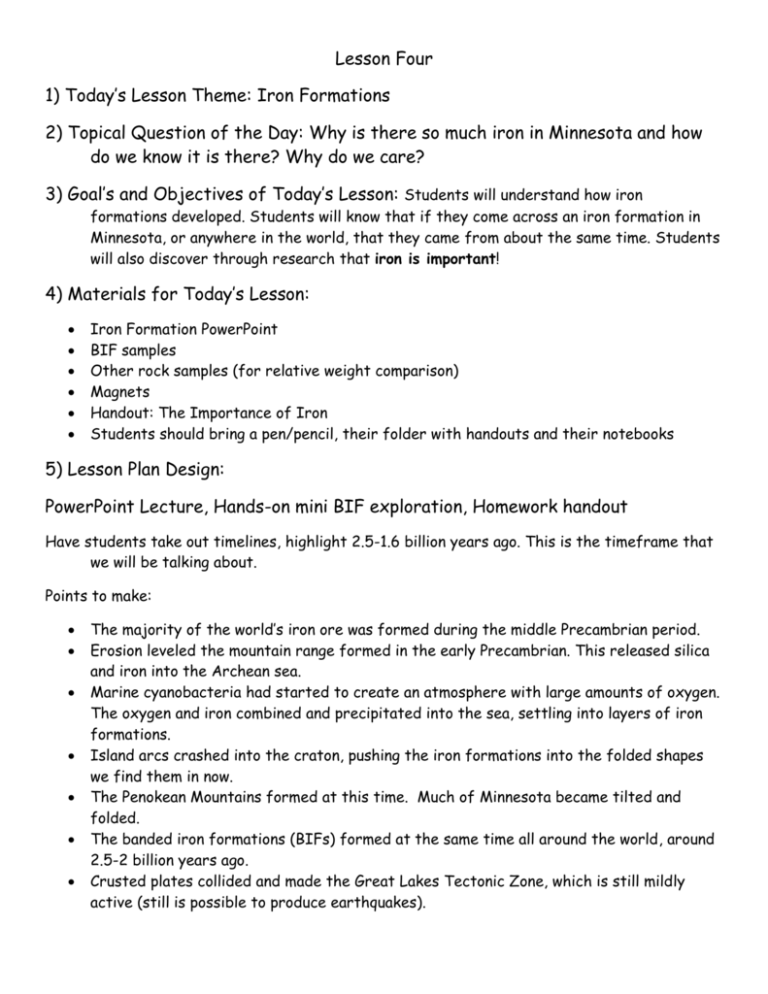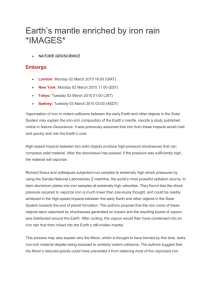Geology Lesson Plan-
advertisement

Lesson Four 1) Today’s Lesson Theme: Iron Formations 2) Topical Question of the Day: Why is there so much iron in Minnesota and how do we know it is there? Why do we care? 3) Goal’s and Objectives of Today’s Lesson: Students will understand how iron formations developed. Students will know that if they come across an iron formation in Minnesota, or anywhere in the world, that they came from about the same time. Students will also discover through research that iron is important! 4) Materials for Today’s Lesson: Iron Formation PowerPoint BIF samples Other rock samples (for relative weight comparison) Magnets Handout: The Importance of Iron Students should bring a pen/pencil, their folder with handouts and their notebooks 5) Lesson Plan Design: PowerPoint Lecture, Hands-on mini BIF exploration, Homework handout Have students take out timelines, highlight 2.5-1.6 billion years ago. This is the timeframe that we will be talking about. Points to make: The majority of the world’s iron ore was formed during the middle Precambrian period. Erosion leveled the mountain range formed in the early Precambrian. This released silica and iron into the Archean sea. Marine cyanobacteria had started to create an atmosphere with large amounts of oxygen. The oxygen and iron combined and precipitated into the sea, settling into layers of iron formations. Island arcs crashed into the craton, pushing the iron formations into the folded shapes we find them in now. The Penokean Mountains formed at this time. Much of Minnesota became tilted and folded. The banded iron formations (BIFs) formed at the same time all around the world, around 2.5-2 billion years ago. Crusted plates collided and made the Great Lakes Tectonic Zone, which is still mildly active (still is possible to produce earthquakes). Have students examine their BIFs (hints- relative weight and magnetism). They should write these observations down in their notebooks. The iron formations are found by surveying the strength of the gravity and magnetic fields throughout Minnesota. Iron is more dense and magnetic than the surrounding layers. Once the PowerPoint is done, hand out the handout. Explain that it is homework and will be due in two class days from now. Students are allowed to use the class computer at this time to do research. Five minutes before class ends: gather students back to their seats. Have them take out their timelines and find 1.1 billion years ago. Let students know that tomorrow we will be travelling in time, to visit Minnesota Volcanoes! Also remind them that their homework is due in two class days, have them write the due date on their papers. 6) Closure The lesson will end with students set to go out and search for iron use in their environment. We know that Minnesota has so much iron because it was forming at the same time that iron was being deposited in the sea (thanks to the weathering of iron rich mountains and the photosynthesis of Cyanobacteria). There was only a certain time in the Earth’s history where everything was just right to make iron formations, so even if they travel to Africa and come across an iron formation, they will know it formed around 2.5-2 billion years ago. The homework, started in class, stresses the importance of iron in our lives. Be sure to go over your handouts and your notes tonight because there will be a short quiz at the end of tomorrow’s class on the material that we have covered this week. It is ten questions long and is a mix of multiple choice and short answer. Tomorrow in class we will be talking about volcanoes in Minnesota. Pay close attention tomorrow, we will be visiting a place next week that has real volcanic rocks exposed! Name________________ Homework Due _________ The Importance of Iron Directions: Complete the Fun Facts and the Scavenger Hunt. You may use the class computer for internet access. Helpful websites: Minerals Information Institute - http://www.mii.org USGS Minerals Information - http://minerals.usgs.gov/minerals/ Fun Facts: Iron is used to make steel (a hint for the scavenger hunt) Pure iron is malleable. Define malleable _____________________ There is so much iron in Minnesota that we have an area known as the Where is the Iron Range? Iron Range. Early Minnesota explorers would have their compasses go crazy when walking over parts of the iron range. Why? (hint-what do compasses point to?) __________________________________________________ List 2 more fun facts you learned, either in class or through your research 1. ______________________________________________________ 2.______________________________________________________ Scavenger Hunt: Find at least 15 things that are made of/with iron that you use on a regular (at least weekly) basis. The person who finds the most gets five points of extra credit! Add more iron items on the back of this page. 1._______________ 2.________________ 3._______________ 4._______________ 5.________________ 6._______________ 7._______________ 8.________________ 9._______________ 10._______________ 11.________________ 12.______________ 13._______________ 14.________________ 15.______________







